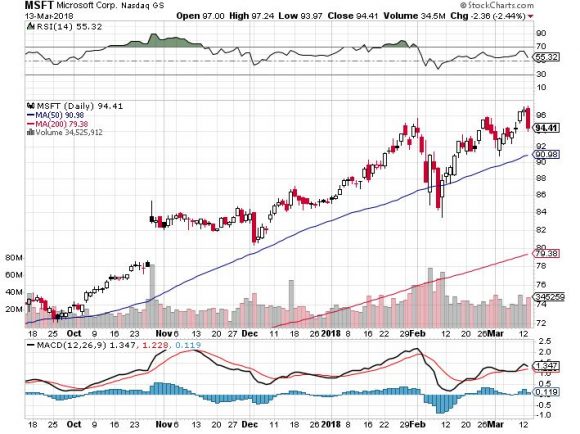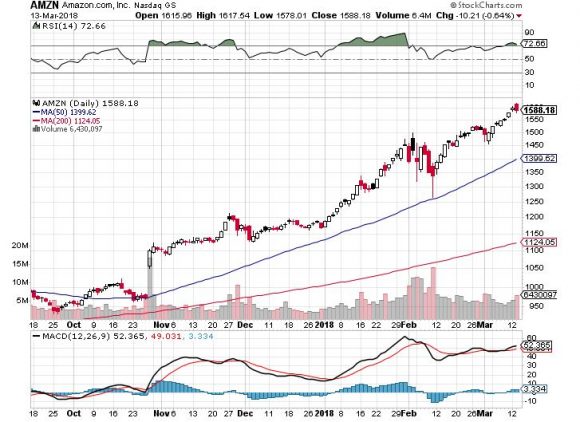Investors are clamoring for cloud plays, which along with artificial intelligence (AI) have become the hottest investment themes of 2018.
However, many are ignoring one of the best new cloud plays of all, and that would be Microsoft (MSFT). However, this is not your father's Microsoft.
Microsoft (MSFT) is the poster boy for legacy tech turned cutting edge once again. It is now one of the top three cloud companies behind Amazon (AMZN) and Google (GOOGL) and is closing fast.
In fact, most people have been using their products for years and have no clue of this amazing turnaround.
This year, 2018, has been the year of the cloud. As such, cloud stocks have been bulletproof, with leaders including Salesforce (CRM) and Red Hat Inc. (RHT) celebrating all-time highs.
The cloud companies are basking in the momentum of rising earnings and accelerating growth. Their fundamental stories are solid, and growth drivers unrelenting.
The No. 1 reason is the sheer increase in global data. Market intelligence services predict total data will grow to 163 zettabytes by 2025, which is 10 times the data generated in 2016.
For all the math geeks out there, 1 zettabyte is a trillion gigabytes.
This incredible volume of data will uncover new types of business and the user experience will evolve. In the near future, more than 20% of the data will be imperative just to normally function by 2025.
Big data is smartly harnessed by all profitable companies today and this data needs storage - huge amounts of it.
Fortune 500 companies operate from cloud software that streamlines and harmonizes operations, which is called enterprise software. The data accumulated on these platforms is digital gold, and infers trends and paradigm shifts on which CEOs base game changing-decisions.
The best up-and-coming cloud business is hands down Microsoft Azure. The existential threat of (MSFT)'s Azure is probably the only thing that keeps Jeff Bezos awake at night.
Azure produced a revenue beat for the ages, increasing by 98% QOQ. Microsoft's Azure public cloud is eating into Amazon Web Services (AWS) market share.
AWS is critical to Amazon's (AMZN) fortunes as its outperformance allows Bezos the cash flow to dump products on its e-commerce platform at or below cost, seizing market share and a higher stock price.
Microsoft delivers hybrid consistency, developer productivity, AI capabilities, and trusted security and compliance on Azure to its corporate customers. Partnering with other firms to provide cloud services is punctuated by bottom- and top-line outperformance.
At the micro level, investors can deduce the sticky underpinnings that are creating a profitable moat around Azure with these few examples.
Microsoft has an important relationship with Chevron (CVX), which uses Azure IoT to harness massive amounts of seismic data from its oil fields to accelerate deployment of modern, intelligent solutions for oil exploration.
Azure's cloud services also help Chevron manage thousands of oil wells dotted around the world, increasing revenue and operating safely and reliably.
Kohler is another company to link up with Microsoft's cloud bundle by building connected, voice-activated products powered by Azure IoT and Johnson Controls (JCI). GLAS thermostat with Cortana voice control uses scalable device management capabilities in Azure IoT and Windows IoT.
The Kroger (KR) supermarket chain is deploying Azure to fuel its digital grocery store display for real-time pricing, discounts and promotions based on shoppers' data to levitate sales.
Home improvement company Lowe's (LOW) in-store robot uses Azure to manage inventory and notify human management of out-of-stock or misplaced items. This is yet another example of humans and robots working in perfect harmony.
These are some of the examples of why Microsoft Azure is tearing into AWS's market share. Azure simply offers a more robust set of cloud software solutions compared to AWS because of its better enterprise functions, and it may become the future for all of us.
Another segment that gets little love is the LinkedIn purchase by Microsoft in 2016. LinkedIn, the employment networking site, aided by strong sales execution totaled $1.3 billion in quarterly revenue. Higher user engagement, customer acquisition, renewals and upsell performance make this the preeminent platform for business networking.
The next step is further integrating the leading professional cloud with the leading professional network. This marks the fifth consecutive quarter of more than 20% growth for LinkedIn. I believe more can be done to monetize LinkedIn, and the potential is enormous.
Another segment that really cuts across the majority of the tech ecosphere via GPUs, A.I., hardware and software is gaming. Today, gaming is as hot as cord cutters, and millennials love playing video games.
Microsoft has been in the gaming space since the beginning, and revenue sprouted up by 8% QOQ driven by hardware revenue growth of 14% QOQ. The hardware comes in the form of premium console, the Xbox One X, the top-selling console in the US this past holiday season.
Microsoft has parlayed its commitments in gaming into acquiring PlayFab, which serves upward of 700 million avid gamers with more than 1,200 games from Disney, Rovio and Atari. It's a unique backend platform for mobile, PC and console game developers to scale up cloud-connected games linked with Azure to provide a world-class cloud platform for the gaming industry.
Microsoft is so much more than just an operating system and Microsoft Office in 2018. That is the old Microsoft. And that being said, Office 365 increased subscribers to 29.2 million last quarter, up from 28 million QOQ.
We have been in and out of Microsoft many times. Now, if it would only give us another decent dip, we could revisit the trough one more time.



